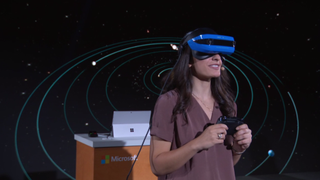Forget virtual reality - Microsoft's Surface Laptop shows it lives in another dimension
Opinion: Will students really bite at a $999 device?

At Microsoft’s #MicrosoftEDU event, CEO Satya Nadella waxed lyrical about the importance of ‘democratising education’ by making technology – and educational tools – available to any student throughout the world.
This is a worthy vision, one where no matter what a child’s background, they will not be left behind while more fortunate students benefit from expensive technology, and by showing off a lightweight Windows 10 S operating system, alongside affordable $189 devices made by third parties, I was almost sold.
But then things went a bit wrong. Microsoft began talking about virtual reality and mixed reality and how essential to learning they will become, and I began questioning what reality Microsoft lived in.
- Let's hope the Surface Book 2 is right around the corner

How could VR replace textbooks?
I know many teachers who are even more passionate about teaching, and making sure their students all have an equal chance of learning, than Microsoft.
They work long hours, they complain about outdated textbooks, budget cuts and the struggle to engage students. None of them have ever said that putting a HoloLens in a classroom would solve that.
Microsoft showed footage of classrooms full of these expensive augmented reality headsets. When teachers in the real world worry that some of their students can’t afford school meals every day.
Do they really think equipping a classroom with one (or more) $3,000 (£2,720, AU$4,370) headsets is going to be a priority?
Get daily insight, inspiration and deals in your inbox
Get the hottest deals available in your inbox plus news, reviews, opinion, analysis and more from the TechRadar team.
Microsoft said that teachers can create lesson plans in AR, draw up immersive, interactive, 3D displays to wow the children. When a teacher has already spent hours after work continuing to mentor and help children, where are they going to have the time to do that? Who will teach the teachers to create these lessons?
How much?!
And then came the announcement of the Surface Laptop. When the rumors emerged this morning, some people (including myself) thought that maybe Microsoft had created an affordable laptop that would target Chromebooks, with a bit of polish and build quality Microsoft’s hardware is known for.
A Chromebook-killing Microsoft device that gave students the opportunity to have a rock-solid machine that lasted them their entire time at school or university, while offering more flexibility than the pared-down Chrome OS software, was a genuinely exciting prospect.
And then Microsoft announced the hardware. It soon became clear that Microsoft was not targeting affordable Chromebooks, but expensive and premium MacBooks. Surface boss Panos Panay boasted about how much more powerful the Surface Laptop is compared to a MacBook.
And then came the price.

For the ‘cheapest’ hardware configuration, Microsoft is asking for $999 (about £773, AU$1,328). That’s a huge price tag that in the real world many students just can’t afford. Microsoft’s Panos Panay spoke about how Microsoft wanted to make a device for everyone, but at that price, it’s a device for hardly anyone.
Apple has the same problem – making products that just don’t target the reality of many students around the world. At least Apple has a desirable brand image that makes some people think that paying extra for a MacBook is worth it. In Microsoft’s Redmond bubble, it’s assumed people are just as enthusiastic about it.
They are not.
I’m sure that the Surface Laptop will be a wonderful and well-built device, but by suggesting it’s a device most students will want, it shows how out of touch Microsoft actually is.
- These are the best laptops you can buy in 2017

Matt is TechRadar's Managing Editor for Core Tech, looking after computing and mobile technology. Having written for a number of publications such as PC Plus, PC Format, T3 and Linux Format, there's no aspect of technology that Matt isn't passionate about, especially computing and PC gaming. Ever since he got an Amiga A500+ for Christmas in 1991, he's loved using (and playing on) computers, and will talk endlessly about how The Secret of Monkey Island is the best game ever made.
Most Popular

